
French postcard by Publistar, Marseille, no. 920. Photo: United-Press.

Spanish postcard by Raker, no. 1106, 1964. Steve McQueen in The Great Escape (John Sturges, 1963).

Spanish postcard by Postal Oscarcolor, no. 330.
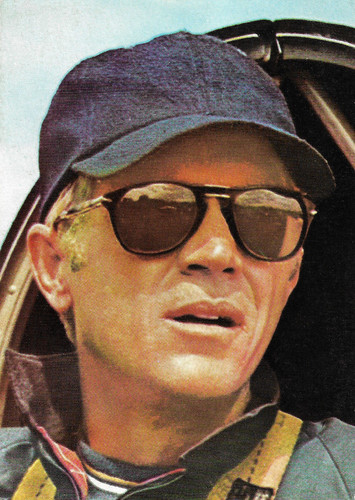
Romanian postcard by Casa Filmului Acin, no. 43080. Steve McQueen in The Thomas Crown Affair (Norman Jewison, 1968).

Romanian postcard by Casa Filmului Acin, no. 43079. Steve McQueen in The Hunter (Buzz Kulik, 1980).
Weekend motorcycle races at Long Island City Raceway
Terence Steve McQueen was born in Beech Grove, a suburb of Indianapolis, in 1930. His childhood was spent on his uncle's farm in Missouri, as his father left home when he was only six months old. His mother followed suit shortly afterwards.
As a teenager, he moved to Los Angeles, where he joined a gang. When he was arrested after an attempted robbery, he ended up in a reform school, the Chino Reform School. He spent a year and a half there and was set straight again. Years later, he set up a fund for that school and even left it $200,000.
In 1947, he joined the Navy, where he clashed several times with his superiors. Three years later, however, he was given an honourable discharge for heroic conduct. This was followed by a series of 12 trades and 13 accidents: construction sites, oil fields, a lumberjack in Canada and even a courier in New York.
McQueen enrolled in a few well-known acting schools and his drive earned him a scholarship from the famous Actors Studio. Long enamoured of cars and motorcycles, McQueen began to earn money by competing in weekend motorcycle races at Long Island City Raceway. He purchased the first two of many motorcycles, a Harley-Davidson and a Triumph. He soon became an excellent racer, winning about $100 each weekend (equivalent to $1,000 in 2022).
In 1955, he made his Broadway debut in the play 'A Hatful of Rain', starring Ben Gazzara. In late 1955 at the age of 25, McQueen left New York and headed for Los Angeles. He moved into a house on Vestal Avenue in the Echo Park area and sought acting jobs in Hollywood.

American playing (post)card. Steve McQueen in Wanted: Dead or Alive (1958-1961).

French postcard by PSG, presented by Corvisart, no. 411. Steve McQueen in Wanted: Dead or Alive (1958-1961).
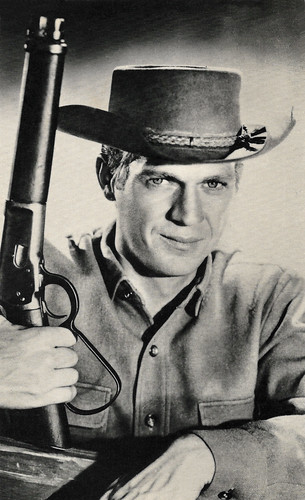
Vintage postcard. Steve McQueen in Wanted: Dead or Alive (1958-1961).

French postcard by E.D.U.G., offered by Corvisart, no. 358. Steve McQueen in Wanted: Dead or Alive (1958-1961).

French postcard by E.D.U.G., no. 411. Steve McQueen in Wanted: Dead or Alive (1958-1961).
His breakout role
Steve McQueen's first breakout role came on television. When McQueen appeared in a two-part Westinghouse Studio One television presentation entitled The Defenders, Hollywood manager Hilly Elkins took note of him. McQueen's first film role was a bit part in Somebody Up There Likes Me (Robert Wise, 1956), starring Paul Newman.
He appeared on Dale Robertson's NBC Western series Tales of Wells Fargo as Bill Longley. McQueen next filmed a pilot episode for what became the series titled Wanted: Dead or Alive, which aired on CBS in September 1958. This became his breakout role. He would later cross over into comparable status on the big screen, making him the first TV star to do so.
His first lead role in the cinema was in the low-budget Sci-Fi film The Blob (Irvin S. Yeaworth Jr., 1958), but his breakthrough was as Vin, alongside Yul Brynner, in the Western The Magnificent Seven (John Sturges, 1960). McQueen's focused portrayal of the taciturn second lead catapulted his career and led to his withdrawal from Wanted: Dead or Alive.
Steve McQueen delivered another crowd-pleaser, the war film The Great Escape (John Sturges, 1963) with James Garner. This film established McQueen's box-office clout and secured his status as a superstar. McQueen earned his only Academy Award nomination in 1966 for his role as an engine-room sailor in The Sand Pebbles (Robert Wise, 1966), in which he starred opposite Candice Bergen and Richard Attenborough.
Riding a wave of popularity, he starred in such hits as The Cincinnati Kid (Norman Jewison, 1965) opposite Ann-Margret, the provocative crime drama The Thomas Crown Affair (Norman Jewison, 1968) with Faye Dunaway, and the mega-hit Bullitt (Peter Yates, 1968), which co-starred Jacqueline Bisset, Robert Vaughn, and Don Gordon and won an Oscar for Best Film Editing (Frank P. Keller). Bullitt is famous for its car chase scene through the streets of San Francisco, which is regarded as one of the most influential in film history.

American postcard by Zoetrope Images LTD., Boston, Mass., no. 404. Steve McQueen in Hell is for Heroes (Don Siegel, 1962).

American postcard by Zoetrope Images LTD., Boston, Mass., no. 430. Steve McQueen in The Great Escape (John Sturges, 1963).

French postcard by Edition A.E.P., Ref. NB14. Steve McQueen in The Sand Pebbles (Robert Wise, 1966).

French postcard, no. C 526. Steve McQueen in Nevada Smith (Henry Hathaway, 1966).
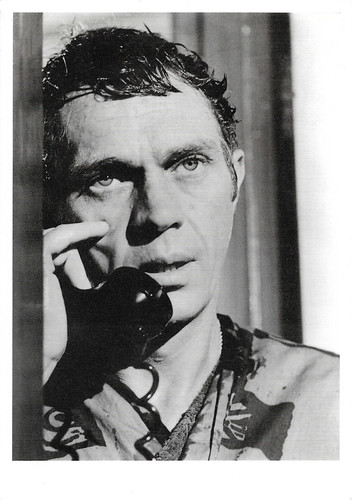
French postcard in the Collection Magie Noire by Editions Hazan, Paris, no. 6343. Steve McQueen in Bullitt (Peter Yates, 1968).
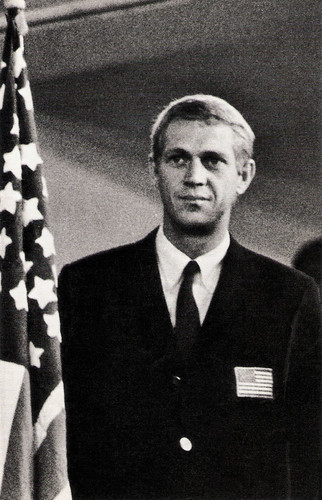
Vintage postcard.
Virile, petulant, slightly paranoid, tormented
Steve McQueen teamed up with maverick Hollywood director Sam Peckinpah for the modern Western Junior Bonner (1972), and The Getaway (1972) with Ali McGraw.
His last great hits were Papillon (Franklin J. Schaffner, 1973) with Dustin Hoffman and the 'disaster' movie The Towering Inferno (John Guillermin, Irwin Allen, 1974) with Faye Dunaway and Paul Newman.
On a personal level, Steve McQueen was as he usually was on the big screen: virile, petulant, slightly paranoid, tormented. He was obsessed with speed and regularly performed very well in national and international motor races. He was also a good marksman and a lover of oriental martial arts. He had a black belt 9th dan in Taekwondo. Together with James Coburn, he was one of the pallbearers of Bruce Lee's coffin.
His last two films were loosely based on true stories: Tom Horn (William Wiard, 1980), a Western about a former Army scout-turned-professional gunman who worked for the big cattle ranchers hunting down rustlers, and was later hanged for murder in the shooting death of a sheepherder, and The Hunter (Buzz Kulik, 1980), an action thriller about a modern-day bounty hunter.
In December 1979, he was diagnosed with lung cancer, caused by asbestos. But he kept this a secret until a month before his death. In January 1980, he suffered a heart attack shortly after marrying his third wife. At the end of 1980, he died of another heart attack in Mexico, less than a day after a successful operation to remove tumours from his right lung. Steve McQueen was only 50 years old. He was married to Neile Adams from 1956 to 1972, with whom he had two children. His second wife was Ali MacGraw from 1973 to 1978 and his last wife was Barbara Minty from 16 January 1980 until his death on 7 November of that year.

French collectors card by Publistar, Marseille. Steve McQueen in Wanted: Dead or Alive (1958-1961).

French postcard by Publistar, Marseille, no. 1008. Photo: U.P.I. Steve McQueen in The Great Escape (John Sturges, 1963).

French collectors card by Scarpa, no. 407.

British postcard by Pyramid, no. PC 2091. Reproduction of the film poster for Bullitt (Peter Yates, 1968), starring Steve McQueen.

Belgian collectors card by CLARK Tendermint. Illustration: Tibet.
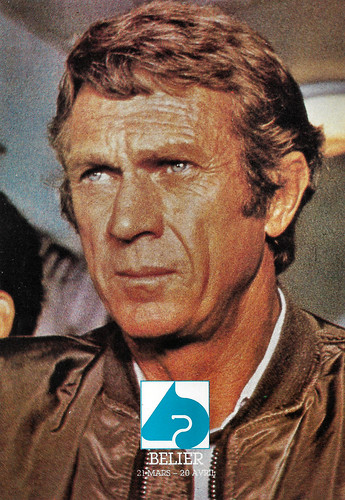
French postcard by Editions F. Nugeron in the 'Signes du zodiaque' series, no. 4, Steve McQueen, Aries (21 March - 20 April). Photo: Steve McQueen in The Hunter (Buzz Kulik, 1980).
Sources Wikipedia (Dutch and English) and IMDb.
No comments:
Post a Comment